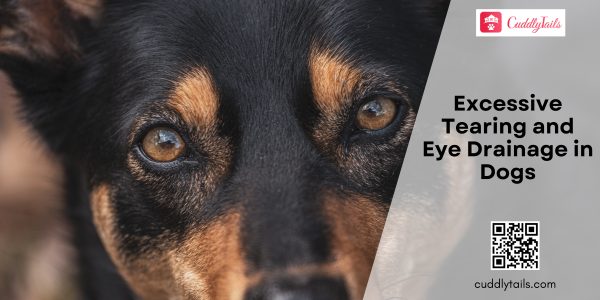Excessive Tearing and Eye Drainage in Dogs
Dogs often steal our hearts with their soulful eyes, but what happens when those eyes are constantly tearing up or appear irritated? Excessive tearing and eye drainage in dogs are not only unsightly but could also indicate a health problem.
Understanding Normal Tear Production in Dogs
Dogs have a tear film that helps keep their eyes moist and healthy. This tear film is made up of three layers – mucous, aqueous, and lipid – each playing a crucial role in maintaining eye health. Normal tear production is essential for clear vision and overall eye comfort in our four-legged companions.
Causes of Excessive Tearing in Dogs
Genetic Predispositions and Breed-Specific Factors
Just like some humans inherit dimples or freckles, certain dog breeds are more prone to excessive tearing due to genetic factors.
Infections and Inflammation
Sometimes, our canine companions can experience eye infections or inflammation, leading to excessive tearing and eye drainage.
Environmental Irritants and Allergies
Allergies are a frequent culprit. Dogs can react to environmental allergens like pollen, dust, or mold, leading to watery eyes and irritation.
Blocked Tear Ducts
A physical obstruction in the tear ducts can prevent proper drainage, leading to accumulation and overflow of tears.
Common Symptoms and Signs of Eye Drainage in Dogs
Visible Tear Stains and Discharge
These visible signs can indicate underlying issues causing excessive drainage from your pup’s eyes.
Behavioral Changes and Discomfort
If your dog starts rubbing their eyes frequently, squinting more than usual, or avoiding bright lights, it might be a sign of discomfort caused by excessive tearing. Behavioral changes can clue you into your pup’s distress signals.
Diagnosis and Veterinary Examination for Eye Drainage in Dogs
Physical Examination and Eye Assessment
A veterinarian can perform a thorough eye exam, including tests like the Schirmer tear test to measure tear production and staining techniques to identify blockages or corneal scratches.
Diagnostic Tests and Procedures
From eye swabs to tear tests, veterinarians have an array of diagnostic tools at their disposal to get to the bottom of your dog’s watery eye mystery. These tests help identify infections, allergies, or any underlying conditions that may be causing eye drainage.
Treatment Options for Excessive Tearing in Dogs
Medication and Prescription Eye Drops
When it comes to treating excessive tearing in dogs, your veterinarian may prescribe medications or specialized eye drops to help alleviate the issue. These can help reduce inflammation, manage infections, or address underlying conditions causing excessive tearing.
Surgical Interventions and Procedures
In severe cases where medications or other treatments are not effective, surgical interventions may be recommended. Procedures like eyelid corrections or tear duct flushing can help improve tear drainage and reduce excessive tearing in dogs.
Preventive Measures and Home Care for Dogs with Eye Drainage
Proper Hygiene and Grooming Practices
Maintaining proper hygiene and grooming practices is crucial for dogs experiencing eye drainage. Regularly cleaning around the eyes with a damp cloth and keeping fur trimmed around the eye area can help prevent irritation and infections.
Dietary Considerations and Nutritional Supplements
A balanced diet rich in essential nutrients is essential for your dog’s overall health, including their eye health. Consider adding omega-3 fatty acids or other nutritional supplements to support eye function and reduce inflammation associated with excessive tearing.
Monitoring Allergies and Irritants
If your dog has known allergies, minimizing exposure to allergens like pollen, dust, and smoke is crucial. Keep windows closed during high-pollen seasons and use air purifiers indoors. Regularly vacuum your home and wash your dog’s bedding to reduce potential triggers.
Regular Veterinary Check-Ups
Routine check-ups are invaluable for catching early signs of eye problems. Your vet can identify issues before they become severe, such as minor infections or irritations.
Complications and Long-Term Management of Excessive Tearing in Dogs
Secondary Infections and Ongoing Monitoring
Excessive tearing can make dogs more susceptible to secondary infections, such as conjunctivitis. Regular vet check-ups and ongoing monitoring are crucial to catch any complications early and provide timely treatment to prevent further issues.
Lifestyle Adjustments for Dogs with Chronic Eye Issues
For dogs with chronic eye issues leading to excessive tearing, lifestyle adjustments may be necessary. This can include protecting your dog’s eyes from environmental irritants, avoiding activities that worsen tearing, and providing a comfortable living environment to promote eye health.
Conclusion
Excessive tearing and eye drainage in dogs can range from a minor inconvenience to a serious health concern. Understanding the causes, symptoms, and treatments is vital for maintaining your furry friend’s eye health. With proper care, early intervention, and regular veterinary visits, you can ensure your dog enjoys a clear and comfortable view of the world.
FAQs
Can excessive tearing resolve on its own?
In some cases, mild excessive tearing caused by temporary irritants may resolve on its own. However, persistent tearing often requires veterinary attention.
What is the best way to clean my dog’s eyes?
Use a damp, soft cloth or pet-safe wipes to clean around the eyes. For deeper cleaning, a sterile saline solution can help flush out debris.
Are certain dog foods better for eye health?
Yes, foods rich in omega-3 fatty acids, antioxidants, and vitamins A and E can promote eye health. Consult your vet for recommendations tailored to your dog’s needs.
Can I use human eye drops on my dog?
No, human eye drops are not formulated for dogs and may cause harm. Always use veterinary-approved eye drops for your pet.
How often should I check my dog’s eyes?
Check your dog’s eyes daily for signs of irritation, redness, or discharge. Regular observation helps catch potential issues early.

